![]()
What Is the Best Time to Visit Ireland? A Comprehensive Guide
When it comes to planning a trip to Ireland, timing is everything. The Emerald Isle offers a rich tapestry of landscapes, history, and culture, but the best time to experience its magic depends on your preferences and interests. Whether you’re drawn to lush green countryside, vibrant festivals, or cozy pub sessions, Ireland has something to offer year-round.
Ireland: A Journey Through the Seasons

Imagine standing on the rugged cliffs of Moher, the salty breeze tousling your hair as you gaze out over the vast Atlantic Ocean. The emerald green fields stretch endlessly before you, dotted with ancient stone walls and grazing sheep. This is Ireland—the land of myths, legends, and breathtaking beauty.
But when is the best time to experience this enchanting allure? Let’s embark on a journey through the seasons, each offering its unique magic:
key Takeaways : What is the best time to visit Ireland?
| Season | Highlights |
|---|---|
| Spring | Wildflowers, mild weather, St. Patrick’s Day celebrations |
| Summer | Extended daylight, festivals, warm weather |
| Autumn | Fall foliage, fewer crowds, cozy traditional music sessions |
| Winter | Christmas markets, coastal storms, indoor comforts |
Remember, the best time depends on your preferences! 🍀
Spring in Ireland: A Season of Blooms and Festivities

As winter’s chill retreats, Ireland awakens in a burst of color. Spring, with its delicate wildflowers and mild weather, beckons travelers to explore its enchanting landscapes. Here’s why this season might just be the best time for your Irish escapade:
- Wildflowers and Blossoms: Picture fields adorned with iconic yellow daffodils and delicate cherry blossoms. Ireland’s gardens and hedgerows come alive, creating a vibrant tapestry of colors. Whether you’re strolling through a city park or hiking along a coastal trail, the blooms add an extra touch of magic.
- Mild Weather: Spring temperatures hover around 50°F (10°C). It’s neither too cold nor too hot, making it ideal for outdoor adventures. Shed your winter coat and explore without the summer crowds. Feel the crisp air as you wander through ancient ruins or meander along scenic paths.
- St. Patrick’s Day: If you happen to be in Ireland on March 17th, you’re in for a treat. Join the lively St. Patrick’s Day celebrations in Dublin or any other town. The streets come alive with parades, music, and dancing. Raise a pint of Guinness to the patron saint and revel in the festive spirit.
In spring, the lambs frolic in green pastures, and the promise of longer days hangs in the air. Whether you’re a nature enthusiast, a history buff, or simply seeking a memorable experience, Ireland’s springtime charm awaits. So pack your raincoat, embrace the blooming landscapes, and let the magic of the Emerald Isle capture your heart. Sláinte! 🌼🍀
Read More:
4 DAY IRELAND ITINERARY: THE ULTIMATE GUIDE FOR FIRST-TIME VISITORS
Summer in Ireland: Long Days, Festivals, and Coastal Magic
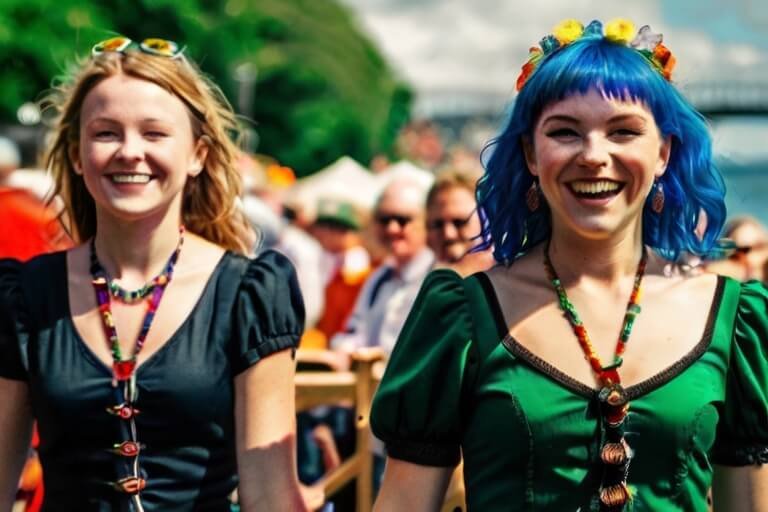
As the sun graces the Emerald Isle, summer casts its enchanting spell. Here’s why this season is a traveler’s delight:
- Extended Daylight: The days stretch until 10 p.m., giving you ample time to explore. Imagine wandering through ancient castles, tracing the rugged coastline, or simply sitting by the sea, sipping a pint of Guinness.
- Festivals Galore: Ireland comes alive with cultural celebrations. The Galway Arts Festival dazzles with art, music, and theater. Meanwhile, the Lisdoonvarna Matchmaking Festival promises lively dances and romantic encounters.
- Warm Weather: Average temperatures range from 60°F to 70°F (15°C to 21°C). It’s perfect for outdoor adventures—whether you’re hiking, cycling, or picnicking in lush green meadows.
So pack your sunscreen, embrace the festive spirit, and let Ireland’s coastal beauty captivate you. Summer memories await! 🌞🍀
Autumn in Ireland: A Symphony of Colors and Cozy Moments
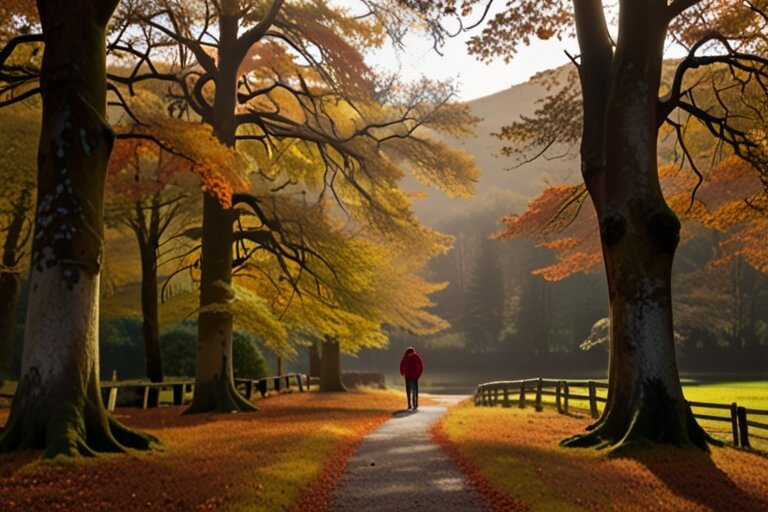
As summer fades, Ireland embraces autumn with open arms. The air turns crisper, and the landscapes transform into a canvas of warm hues. Here’s why this season is a magical time to explore the Emerald Isle:
- Fall Foliage: Picture the Wicklow Mountains ablaze with reds, oranges, and yellows. The trees shed their leaves, carpeting the trails in a mosaic of colors. Hiking through this natural wonder feels like stepping into a painting.
- Crowd-Free Attractions: With the summer tourists dispersing, you’ll have more space to appreciate iconic sights. Stand on the Cliffs of Moher, the wind tousling your hair, and soak in the breathtaking views of the Atlantic Ocean. Or drive along the scenic Ring of Kerry, where every turn reveals a new vista.
- Cozy Evenings: As daylight wanes, cozy pubs beckon. Imagine sitting by a crackling fireplace, sipping a pint of stout, while traditional Irish music fills the air. The warmth of community envelops you, and conversations flow freely.
- Harvest Season: Autumn also brings the harvest—a time when farmers gather their crops. Visit local markets to taste fresh apples, pumpkins, and artisanal cheeses. The flavors of Ireland come alive, and farm-to-table experiences await.
Whether you’re an adventurer seeking colorful trails or a soul yearning for intimate moments, Ireland in autumn delivers. Wrap yourself in a woolen sweater, breathe in the earthy scents, and let the golden season embrace you. Sláinte! 🍂🍁🍀
Winter in Ireland: Cozy Firesides and Stormy Coastlines

As winter blankets Ireland, the landscape transforms into a realm of misty mornings and woolly sweaters. Here’s why this season holds its own magic:
- Dublin’s Christmas Markets: The city sparkles with festive lights, and Christmas markets come alive. Stroll through stalls selling handmade crafts, warm pastries, and mulled wine. The air is filled with anticipation, and the spirit of the season envelops you.
- Coastal Storms: Along the rugged coastline, storms brew. Waves crash against ancient cliffs, creating a dramatic spectacle. Wrap yourself in a sturdy coat and witness the raw power of the Atlantic Ocean. It’s a reminder of Ireland’s wild beauty.
- Indoor Comforts: Seek refuge from the blustery weather. Cozy up by a crackling fireplace with a hot whiskey in hand. Imagine the warmth seeping into your bones as you listen to tales of old or lose yourself in a good book.
- Historic Castles: Without the summer crowds, explore Ireland’s historic castles. Wander through centuries-old halls, climb spiral staircases, and imagine the lives of kings and queens. The stone walls hold secrets, waiting for you to uncover them.
Conclusion So, what is the best time to visit Ireland? It ultimately depends on your preferences. Whether you’re drawn to spring blossoms, summer festivals, autumn foliage, or winter coziness, Ireland’s charm will capture your heart. Plan your adventure, and may your journey be as epic as the tales whispered by the hearth. Sláinte! 🍀🔥
Discovering Ireland: A 10-Day Journey Through the Seasons
Ireland, with its rolling green hills, ancient castles, and lively pubs, beckons travelers year-round. But when is the best time to experience its magic? In this comprehensive guide, we’ll take you on a 10-day adventure, exploring the Emerald Isle during each season. From spring blossoms to winter coziness, get ready for an extraordinary voyage. Let’s dive into the best time to visit Ireland! 🍀
Day 1: Spring Awakening (March)
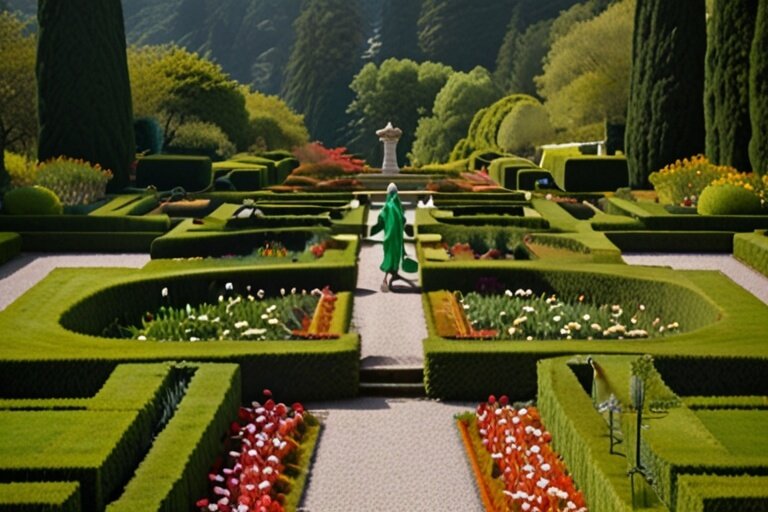
“When the daffodils bloom and the lambs frolic”
- Morning: Arrive in Dublin, where the air is crisp and fragrant. Explore Trinity College and its famous Book of Kells.
- Afternoon: Head to Powerscourt Gardens in County Wicklow. Marvel at the vibrant blooms and terraced landscapes.
- Evening: Join the locals at a cozy pub for traditional Irish music and a pint of Guinness.
Day 2: Coastal Charms (April)
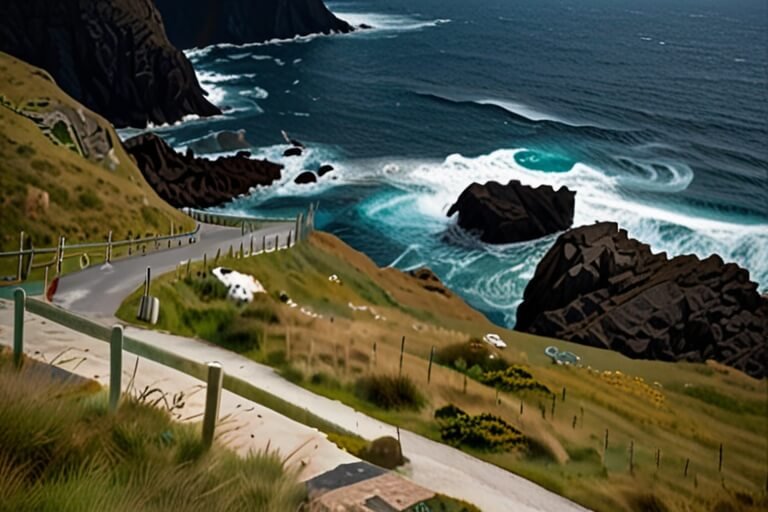
“Cliffs, waves, and salty breezes”
- Morning: Drive to the Cliffs of Moher. Stand on the edge and feel the Atlantic winds whip your hair.
- Afternoon: Visit the Burren—a limestone wonderland—and explore ancient dolmens.
- Evening: Dine in Doolin, known for its seafood and lively music scene.
Day 3: Galway & Connemara (May)
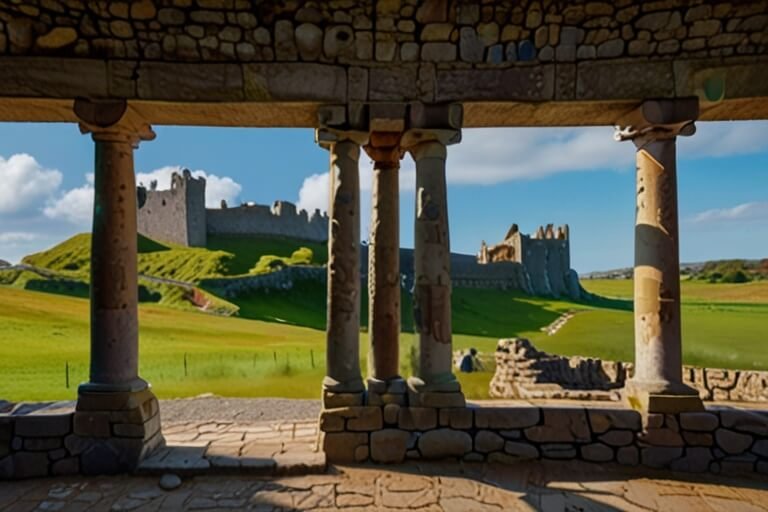
“Wild landscapes and vibrant festivals”
- Morning: Explore Galway’s cobblestone streets and colorful buildings.
- Afternoon: Drive to Connemara National Park. Hike the Diamond Hill trail for panoramic views.
- Evening: Attend the Galway Arts Festival—a celebration of creativity and culture.
Day 4: Summer Solstice (June)
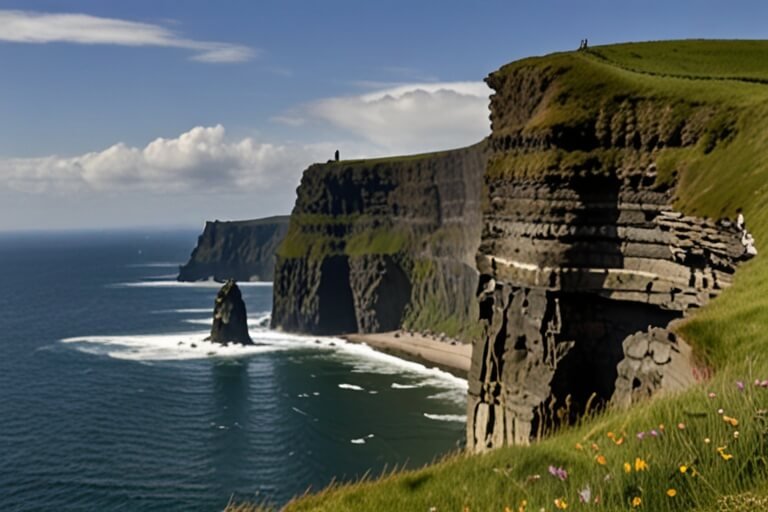
“Long days, festivals, and coastal adventures”
- Morning: Take a ferry to the Aran Islands. Cycle along rugged cliffs and visit ancient forts.
- Afternoon: Return to Galway for the lively Galway Oyster Festival.
- Evening: Sunset cruise on Lough Corrib.
Day 5: Wicklow Wanderings (July)
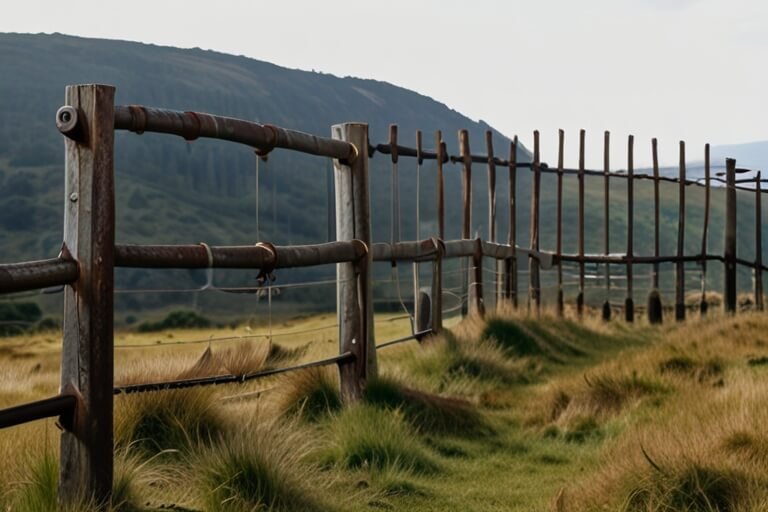
“Gardens, waterfalls, and literary magic”
- Morning: Visit Glendalough—a monastic site surrounded by serene lakes.
- Afternoon: Explore Powerscourt Waterfall, Ireland’s highest waterfall.
- Evening: Literary pub crawl in Dublin—raise a glass to James Joyce and Oscar Wilde.
Day 6: Autumn Colors (September)
“Golden hues and cozy evenings”
- Morning: Drive to Killarney National Park. Hike to Torc Waterfall.
- Afternoon: Explore Muckross House and its gardens.
- Evening: Trad music session at Kate Kearney’s Cottage.
Day 7: Ring of Kerry (October)
“Coastal vistas and ancient forts”
- Morning: Drive the scenic Ring of Kerry. Stop at Staigue Fort.
- Afternoon: Visit Skellig Michael (weather permitting)—a UNESCO World Heritage Site.
- Evening: Warm up by the fireplace at a charming B&B.
Day 8: Winter Whispers (December)
“Firesides, woolly sweaters, and misty mornings”
- Morning: Explore Dublin’s Christmas markets. Sip mulled wine and shop for handmade crafts.
- Afternoon: Visit Kilmainham Gaol—a historic prison with a haunting past.
- Evening: Cozy up in a Temple Bar pub.
Day 9: New Year’s Eve (January)
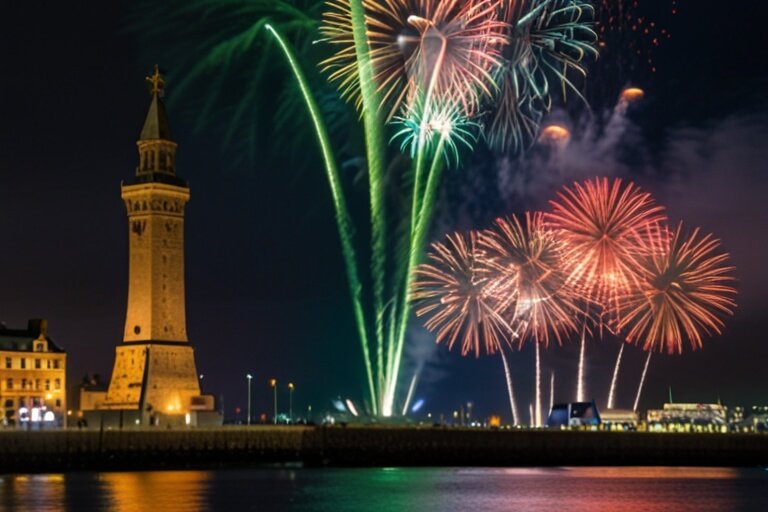
“Countdowns, fireworks, and Irish cheer”
- Morning: Take a scenic train ride to Belfast. Visit the Titanic Belfast museum.
- Afternoon: Explore the Giant’s Causeway—a geological marvel.
- Evening: Celebrate New Year’s Eve in Belfast’s Cathedral Quarter.
Day 10: Farewell (February)
“Reflections, souvenirs, and memories”
- Morning: Reflect on your journey at Howth Head. Watch the sunrise over Dublin Bay.
- Afternoon: Last-minute shopping on Grafton Street.
- Evening: Raise a glass to Ireland—a land of legends and laughter.
No matter the season, Ireland’s allure will stay with you long after you’ve left its shores. Sláinte! 🌿🌊🍻
Estimated Costs : For a Trip to Ireland
Let’s break down the estimated costs for a trip to Ireland, considering transportation, accommodation, food, and activities. Keep in mind that these estimates are based on a one-week itinerary for a single person. If you’re traveling as a couple, you can double the accommodation costs.
| Category | Estimated Cost (USD) |
|---|---|
| Airfare | $700 |
| Accommodations | $1,200 (varies by location) |
| Local transportation | $200 |
| Attractions | $100 |
| Food & drink | $385 ($55 per day) |
| Random Spending | $200 |
| Total | $2,785 |
Please note that these costs are approximate and can vary based on personal preferences, exchange rates, and specific choices during your trip. Let’s delve into each category:
- Airfare:
- Prices fluctuate based on the season and airline.
- Shoulder seasons (Spring and Fall) offer better fares.
- Major carriers like Delta and Air Canada fly to Dublin.
- Accommodations:
- Costs vary by location (city vs. countryside).
- Consider budget-friendly hostels, B&Bs, or mid-range hotels.
- Local Transportation:
- Rely on public transportation (buses, trains) and day tours.
- Car rental is an option but not included in this estimate.
- Attractions:
- Explore historical sites, castles, and natural beauty.
- Entrance fees vary; plan for guided tours if desired.
- Food & Drink:
- Budget around $55 per day for meals and beverages.
- Try traditional Irish dishes and local pubs.
- Random Spending:
- Allow for souvenirs, small purchases, and unexpected expenses.
Remember, Ireland isn’t a cheap destination, but savvy travelers can reduce costs by planning wisely.
Frequently Asked Questions (FAQs) about traveling to Ireland:
| FAQ | Answer |
|---|---|
| 1. When is the best time to visit Ireland? | The best time depends on your preferences. Consider shoulder seasons (spring and fall) for fewer crowds and milder weather. |
| 2. What are the pros and cons of visiting Ireland in summer (June, July, and August)? | Pros: Warmest months. Cons: Crowded and higher flight prices. |
| 3. Is winter (December, January, and February) a good time to visit Ireland? | Yes, if you’re on a budget. Lower prices, but colder weather. |
| 4. What’s the weather like in March? | Spring arrives, and St. Patrick’s Day festivities happen. |
| 5. Can I visit Ireland in January or February? | Yes, but expect cold, wet, and windy days. |
| 6. Are there any attractions closed during the off-season? | Some seasonal attractions may be closed in winter. |
| 7. What should I pack for Ireland in any season? | Layered clothing, waterproof jacket, comfortable shoes, warm sweaters, and a swimsuit. |
| 8. What type of adapter do I need for Irish sockets? | Type G (three rectangular prongs). |
| 9. Is Ireland rainy year-round? | Rain is common, but the changes in weather are not extreme. |
| 10. Can I visit Ireland on a tight budget? | Yes, especially in January and February. |
| 11. What’s the best month for festivals and fall colors? | September and October. |
| 12. Is March a good time for St. Patrick’s Day celebrations? | Yes, but expect higher prices. |
| 13. What’s the best time for golf, flowers, and coastal drives? | April to June. |
| 14. Are July and August sunny in Ireland? | Yes, but also crowded. |
| 15. What’s the average temperature in January? | 7°C (44.6°F) with lows of 3°C (37.4°F). |
| 16. Should I visit Ireland in February? | Yes, if you’re budget-conscious. |
| 17. What’s the weather like in February? | Similar to January—cold, wet, and windy. |
| 18. Can I experience St. Patrick’s Day festivities in March? | Yes, but prepare for sizable expenses. |
| 19. Is spring far from the horizon in February? | Yes, but it’s still chilly. |
| 20. What’s the average temperature in February? | Highs of 8°C (46.4°F) and lows of 2°C (35.6°F). |
| 21. What’s the best time for fall colors and festivals? | September and October. |
| 22. Can I visit Ireland during the off-season? | Yes, but expect shorter days and potentially poor weather. |
| 23. Is Ireland crowded during the summer months? | Yes, especially in July and August. |
| 24. What’s the best time for sunny days and coastal drives? | July and August. |
| 25. Can I visit Ireland all year round? | Yes, but choose the season that suits your preferences. |
